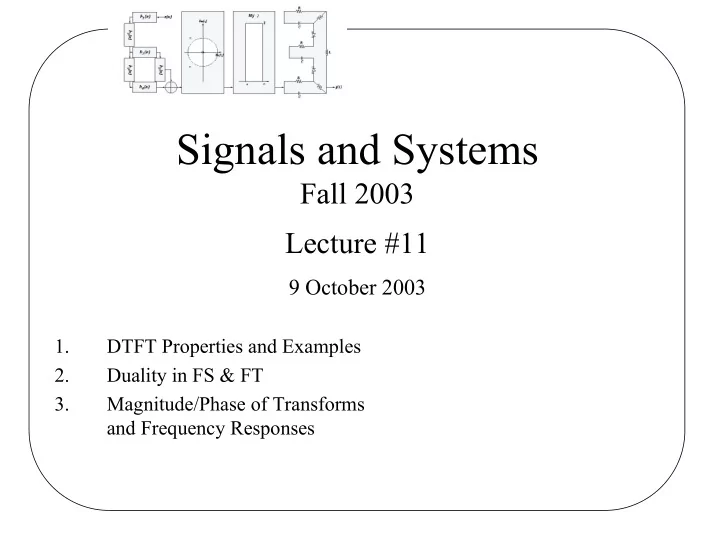

Signals and Systems Fall 2003 Lecture #11 9 October 2003 1. DTFT Properties and Examples 2. Duality in FS & FT 3. Magnitude/Phase of Transforms and Frequency Responses
Convolution Property Example
DT LTI System Described by LCCDE’s — Rational function of e -j ω , use PFE to get h [ n ]
Example: First-order recursive system with the condition of initial rest ⇔ causal
DTFT Multiplication Property
Calculating Periodic Convolutions
Example:
Duality in Fourier Analysis Fourier Transform is highly symmetric CTFT: Both time and frequency are continuous and in general aperiodic Same except for these differences Suppose f ( • ) and g ( • ) are two functions related by Then
Example of CTFT duality Square pulse in either time or frequency domain
DTFS Duality in DTFS Then
Duality between CTFS and DTFT CTFS DTFT
CTFS-DTFT Duality
Magnitude and Phase of FT, and Parseval Relation CT: Parseval Relation: Energy density in ω DT: Parseval Relation:
Effects of Phase • Not on signal energy distribution as a function of frequency • Can have dramatic effect on signal shape/character — Constructive/Destructive interference • Is that important? — Depends on the signal and the context
Demo: 1) Effect of phase on Fourier Series 2) Effect of phase on image processing
Log-Magnitude and Phase Easy to add
Plotting Log-Magnitude and Phase a) For real-valued signals and systems Plot for ω ≥ 0 , often with a logarithmic scale for frequency in CT b) In DT, need only plot for 0 ≤ ω ≤ π (with linear scale) c) For historical reasons, log-magnitude is usually plotted in units of decibels (dB): power magnitude So… 20 dB or 2 bels : = 10 amplitude gain = 100 power gain
A Typical Bode plot for a second-order CT system 20 log| H ( j ω )| and ∠ H ( j ω ) vs. log ω 40 dB/decade Changes by - π
A typical plot of the magnitude and phase of a second- order DT frequency response 20log| H ( e j ω )| and ∠ H ( e j ω ) vs. ω For real signals, 0 to π is enough
Recommend
More recommend